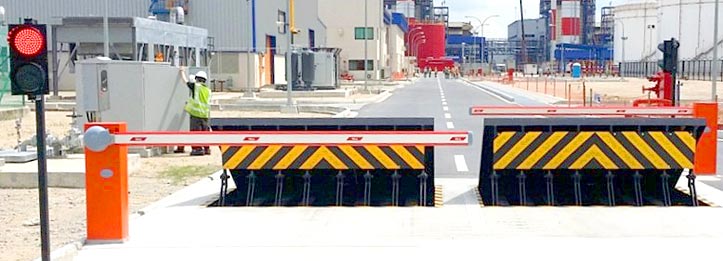The Basic Principles Of Wedge Barriers


18 might be done quicker, quickly, and cost successfully. FIG. In certain personifications, the anchor 30 might be a steel framework including plates, light beams(e. g., I-beams ), and/or other frameworks that are secured within the structure 14, which might be concrete. At the surface 12, an upper side 28 of the support 30 may go to the very least partially revealed
, thus making it possible for the accessory of the barrier 10 to the support 30. g., threaded openings)in one or more light beams or plates of the anchor 30 may be subjected to the surface 12. In this way, screws 32 or other mechanical bolts might be made use of to secure the obstacle 10 to the support 30. As the obstacle 10 is mounted to the surface 12 of the foundation 14, collection of particles and other material underneath the obstacle might be reduced, and components of the bather 10 might not be exposed to below quality environments. As suggested by referral character 52, the lifting system 50 consists of parts disposed underneath the wedge plate 16. The parts 52 below the wedge plate 16 might consist of an electromechanical actuator, a cam, one or even more camera surfaces, and so forth. Additionally, the training system 50 consists of a spring assembly 54
The springtime rod 58 is combined to a web cam(e. g., cam 80 revealed in FIG. 4) of the lifting device 50. The springs 60 disposed about the spring pole 58 are held in compression by springtime sustains 62, including a fixed springtime assistance 64. That is, the fixed spring support 64 is repaired about the foundation 14 et cetera of the bather 10.
Fascination About Wedge Barriers
g., spring support 65 )might be taken care of to the end of the spring pole 58 to make it possible for compression of the springtimes 60. As the springtimes 60 are compressed between the spring sustains 62, the springtime assembly 54 generates a force acting on the web cam coupled to the springtime rod 58 in a direction 66. The continuing to be pressure applied to
the cam to deploy the wedge plate 16 may might provided offered an electromechanical actuator 84 or other various other. The springtime assembly 54 and the actuator 84(e. g., electromechanical actuator)might operate together to equate the camera and lift the wedge plate 16.
As pointed out over, the spring setting up 54 puts in a constant pressure on the cam, while the electromechanical actuator might be regulated to put in a variable pressure on the webcam, consequently enabling the training and decreasing( i. e., deploying and pulling back )of the wedge plate 16. In particular personifications, the continuous pressure applied by the springtime setting up 54 might be adjustable. g., electromechanical actuator) is handicapped. As will certainly be valued, the springtime assembly 54 may be covered and safeguarded from debris or various other components by a cover plate(e. g., cover plate 68 revealed in FIG. 4) that might be substantially flush with the elevated surface 38 of the foundation 14. As discussed above, in the deployed setting, the wedge plate 16 serves to obstruct gain access to or travel beyond the barrier 10. For instance, the barrier 10(e. g., the wedge plate 16 )may block pedestrians or cars from accessing a building or path. As talked about over, the barrier 10 is connected to the anchor 30 safeguarded within the foundation 14,

front brackets 71. Because of this, the affiliation assemblies 72 might pivot and turn to enable the collapse and expansion of the linkage settings up 72 during retraction and implementation of the bather 10. The affiliation settings up 72 cause activity of the wedge plate 16 to be restricted. If an automobile is traveling in the direction of the released wedge plate 16(e. For instance, in one scenario, the security legs 86 might be prolonged throughoutmaintenance of the barrier 10. When the safety and security legs 86 are deployed, the safety and security legs 86 sustain the weight of the wedge plate 16 against the surface site web 12. Because of this, the training mechanism 50 might be shut down, serviced, removed, changed, etc. FIG. 5 is partial perspective view of an embodiment of the surface-mounted wedge-style obstacle 10, showing the cam 80 and the web cam surfaces 82 of the lifting system 50. Specifically, two webcam surface areas 82, which are referred to as reduced webcam surface areas 83, are positioned below the cam 80. The lower webcam surface areas 83 may be taken care of to the surface area 12 (e. For instance, the reduced cam surface areas 83 and the placing plate 85 may develop a single item that is secured to the support 30 by screws or various other mechanical fasteners. Furthermore, 2 cam surfaces 82, which are referred to as top cam surfaces 87, are try this website placed above the webcam 80 and paired to (e. In various other embodiments, interfering layers or plates might be placed in between the surface 12 and the lower web cam surfaces 83 and/or the wedge plate 16 and the upper cam surfaces 87 As stated above, the cam
80 translates along the cam surfaces 82 when the wedge plate 16 is lifted from the retracted position to the deployed position. Furthermore, as pointed out over, the springtime setting up 54 (see FIG. 3 )may provide a force acting on the webcam 80 in the direction 102 via springtime pole 58, which may minimize the pressure the electromechanical actuator 84 is required to put on the cam 80 in order to actuate and lift the wedge plate 16. 1 )to the released position(see FIG. 4). As revealed, the webcam 80 consists of track wheels 104(e. g., rollers), which call and equate along the cam surfaces 82 throughout operation.